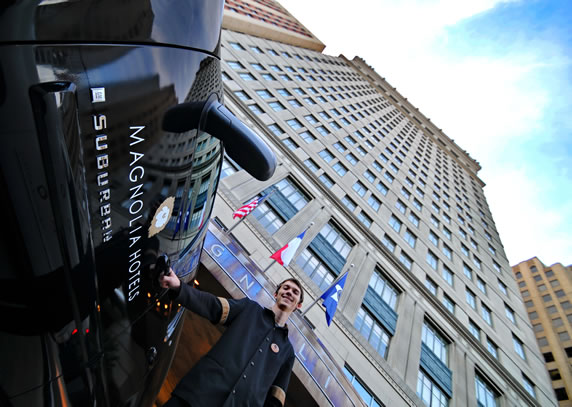High-rise hotels offer up some unique challenges. Regardless of the economy, guest satisfaction scores correlate with guest retention, length of stay, and overall hotel success – which ultimately contribute to a healthier bottom line. And facilities management plays an important role in making sure guests are satisfied with hotel facilities and amenities.
So how do you overcome common high-rise hotel design and operations challenges to stand out as one of the best-run towers in the business? It all comes down to addressing the needs and concerns of guests.
Changing Interior Spaces
Brad Richards, AIA, principal for Baskervill’s hospitality sector.
Incorporating communal tables, corner banquettes, and small “pods” of space tucked beneath escalators provide guests with a range of gathering spaces to choose from. The Millennial Generation is helping drive this shift to more public spaces throughout the hotel facility, explains Brad Richards, AIA, principal for Baskervill’s hospitality sector. As Millennials come into positions of influence, they’ll be engaged in business travel for the next two or three decades. “This generation doesn’t differentiate between work and play. They’re very good at staying attuned to both of those worlds, and that’s how they want hotel spaces to be designed. Public spaces, for example, need to be flexible and provide different levels of intimacy to help feed that balance of work and play.”
This new generation of travelers is also looking for innovative, photographable spaces to share. “We call it the ‘Instagram effect,’ ” explains Richards. “Anything you can snap a photo of, whether it’s a cool front desk, artwork, outdoor spaces, or the way food is plated – if it’s cool, it’ll be online in 30 seconds.”
The desire for more public space in high-rise hotels has also changed guestroom footprints and design. Rooms are becoming smaller, with fewer pieces of furniture that now serve multiple purposes, says Richards. Guests don’t necessarily need traditional, large desks anymore. “Instead, they might be working on a tablet from the bed or sofa,” says Richards. “And they’re probably not going to sit in their rooms very long anyway.”
The new generation of travelers is looking for innovative building features and photographable spaces to share on social media. Public spaces need to be flexible and provide different levels of intimacy to help balance work and play.
Doug Aaron, director of engineering for Magnolia Hotel in Houston and president of Hotel Engineering Association, says the Magnolia plans to upgrade all of its guestrooms with new paint and carpet next year, along with bedding packages. The hotel opened in 2002 after a massive restoration – and right before Super Bowl XXXVIII. The building was originally constructed in 1926 as the first steel and concrete high-rise in Houston. A renovation turned the building from office space back into a historic landmark as Magnolia Hotel. To get ready for the Houston Super Bowl LI in 2017, the Magnolia is spending $1 million in upgrades in 2015 and 2016 to make guestrooms more appealing to younger generations.
Providing multiple exposure points to the outdoors is another way to provide gathering space, says Richards. “The trend has been there, but it’s becoming more literal now. Not only are we talking about physical access, but we’re talking about fresh air being pulled into the hotel in different ways and natural light reaching public spaces,” he explains. Operable windows are one option, as are building envelope systems that allow fresh air to come through “almost like a double layer of skin.”
Rooftop balconies and public spaces aren’t always feasible for high-rises, especially in taller hotel towers, but providing physical access to the outdoors at intermediate levels (such as floors 5, 6, and 7) is becoming more common so guests can step outside without heading down the first floor.
Guests at Magnolia Hotel get to experience the rooftop lap pool as a way to enjoy the outdoors.
Staying Plugged In
Technology is a never-ending, constantly changing issue facing all high-rise hotels, no matter their age or location. “Guests will always be asking, ‘Where can I plug in? Is there wireless everywhere?’ ” emphasizes Richards. Outlets and in-wall USB charging receptacles are starting to leave the desk area and relocate to spots around the room so guests can stay connected without being strapped to a desk.
“There’s a Hilton going through this process right now, designing and upgrading to incorporate technology. It has to be everywhere in a hotel,” explains Richards. It’s becoming best practice to not only plan for current technology trends, but also for future requirements by running conduit for wires that may need to be pulled through at a later date due as technology changes. “There’s also a big push for wireless. It hasn’t hit heavily in the United States yet, but hotels in Asia are already seeing the first wave of wireless controls in guest rooms and lobbies.”
Now a high-rise hotel, Magnolia was the former home of the Houston Post Dispatch newspaper and the original headquarters for Shell Oil Company. After extensive renovation, it has been re-established as a historic landmark and one of Houston’s most distinct properties.
Managing MEP Issues
Smooth operation of mechanical, electrical, and plumbing systems in a high-rise hotel – while not often noticed by guests – is critical to maintaining guest satisfaction scores and reducing complaints.
Plumbing issues are a point of concern simply due to the fact that they move large amounts of water up and down, says Ray Smith, CCP, principal, commissioning/operational phase services section head at GHT Limited. “Code requires – and all manufacturers design to – maximum pressure, which is between 60 and 80 psi, depending on your jurisdiction. But building height limits how far you can go with a pressure zone. In high-rise hotels, you end up with a 10-story pressure zone on average. You’ll have very high pressure on the lower floors where the domestic booster pump is. Ten stories up, there need be two pressure-reducing stations – one for hot, one for cold – that require regular maintenance and periodic adjustments to prevent problems like cold showers.”
Aaron says plumbing is Magnolia Hotel’s biggest challenge. He and his team deal with problems ranging from holes in pipes to plumbing system back-up. “People flush things down toilets that you couldn’t imagine.” To stay on top of this issue, Magnolia developed its Perfect Room Program (PRP). “As part of this program, we try to get in every room twice a year or more, depending on which suites are occupied most.” During those room visits, his team cleans out all drains with a special tool that removes hair and sludge.
Aaron says the Magnolia’s elevators also require constant attention. “We host a lot of weddings during the weekends, as well as volleyball and basketball tournaments. Everyone is trying to get to the same place at the same time, so they all go to the elevators together.” He anticipates elevator lifecycles of 20 to 25 years at his high-rise hotel, and preventive maintenance is key to making sure the elevators will perform as needed during that time.
Ray Smith, CCP, principal, commissioning/operational phase services section head at GHT Limited.
Not only are guest elevators significant, but so are back-of-house elevators. “Speed has more of an increased focus now because it has to do with guest satisfaction scores and staff response time, which also affects scores,” says Smith.
In addition to replacing worn parts, adjusting equipment, and lubricating moving parts, new technology such as destination dispatch controls and variable frequency drives can increase response time, offer higher reliability, and reduce energy costs, says Smith.
High-rise hotels are also saving energy with building controls to manage MEP systems. New technology allows for control systems at the front desk where employees can shut off lights, HVAC, etc. in guestrooms after checkout.
Controlling Thermal Stack Effect
An all-too-common high-rise hotel dilemma occurs when a building engineer leaves a stairwell or mechanical penthouse door open that communicates to outside air. Because the stairwells or mechanical penthouses often have no cooling, the hot, buoyant air tends to draft out in winter months. “You have air that wants to leave, and you have cold, heavier air wanting to provide makeup down in the lobby. It establishes a natural draft tendency.” This problem of thermal stack effect also occurs in elevator shafts.
To fix this problem, a 25-story hotel in New York City recently closed off doors at the top of the building that communicated to outside air. It also installed a vestibule at the lobby level, providing a series of doors for visitors to go through. The facilities team also made sure the mechanical support systems, such as common corridor 100% outside air-handler units, were turned on. “These systems are often off to conserve energy, but that has negative impacts on thermal comfort,” says Smith. “All the exhaust systems are still operating, but the outside air makeup isn’t on. You’ll end up with a very cold lobby if that happens.”
Outdoor space is increasingly a popular amenity for urban travelers. Magnolia Hotel in Houston provides access to the outdoors with its rooftop balcony, pool, and fitness center.
Cash Control
To maintain guest satisfaction levels, improve energy efficiency, and provide long-term cost savings, the Magnolia Hotel recently made investments in lighting and security system upgrades. These projects will result in savings that can be redirected into more building projects to increase guest satisfaction, says Aaron.
His team recently switched out all incandescent lamps for either LEDs or CFLs, and is already experiencing a change. “We noticed utility savings right away; our energy consumption is definitely down. They’re more expensive, but they will pay for themselves pretty quickly if they last like they’re supposed to.”
The hotel also recently completed a $50,000 upgrade to the hotel’s surveillance system. “We added more cameras, and wanted to make the switch from analog to digital to get better resolution so our staff could identify security and safety issues faster.” He says this upgrade makes overnight managers and staff more efficient, and helps them monitor the entire building much more effectively.
Staff: A Good Investment
Although investing in technology upgrades and preventive maintenance will help keep building systems operating, the biggest impact comes from having a good staff who knows the systems. “To be the best that you can be, you need a good crew that will stay with the property and learn the property. The team needs to be excited to be at work every day,” says Doug Aaron, director of engineering for Magnolia Hotel in Houston and president of Hotel Engineering Association. “You might have to pay a little more to get good, qualified people, but investing in them means you won’t have to worry about them leaving.”
Once you have qualified staff members, Aaron says it’s important to dedicate a few specifically to preventive maintenance. “A lot of properties have engineers who are supposed to be doing maintenance on guestrooms, but they’re also being used for room calls and other building projects. You can’t do that,” emphasizes Aaron. “You need a dedicated person whose job is to maintain guestrooms every single day.” The Magnolia consistently has GSI (Guest Satisfaction Index) scores in the 90s, and Aaron is confident that staff dedication to room maintenance is one of the reasons why.



 An award winning editor, Leah spent over eight years in senior editorial positions at both BUILDINGS magazine and ARCHI-TECH magazine. Her work has been incorporated into training and educational programs around the country. She is a graduate of University of Iowa. She is Editor at Large for High Rise Facilities.
An award winning editor, Leah spent over eight years in senior editorial positions at both BUILDINGS magazine and ARCHI-TECH magazine. Her work has been incorporated into training and educational programs around the country. She is a graduate of University of Iowa. She is Editor at Large for High Rise Facilities.